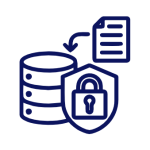Reliable technologies and strategies for data backup and quick restoration in case of data loss.
Data Backup and Restoration Solutions
To ensure reliable data backup and quick restoration in case of data loss, organizations should implement a comprehensive backup and restoration solution that combines robust technologies with effective strategies. Here’s a guide to reliable technologies and strategies for data backup and restoration:
Backup Technologies

Incremental and Differential Backup

Snapshotting

Replication

Cloud Backup
Backup Strategies

Regular Backup Schedule

Multiple Backup Copies

Testing and Validation

Versioning and Retention Policies
Restoration Technologies

Point-in-Time Recovery
Enable point-in-time recovery capabilities to restore data to a specific moment in time, allowing organizations to recover from data corruption, accidental deletions, or logical errors.

Granular Recovery
Implement granular recovery options to restore individual files, folders, databases, or application objects from backup copies without the need for full system restores.

Instant Recovery

Automated Restoration Workflows
Get in Touch Today for Expert Solutions and Support


